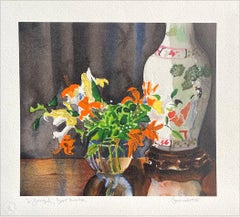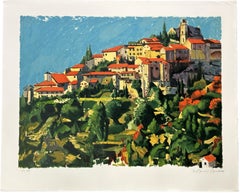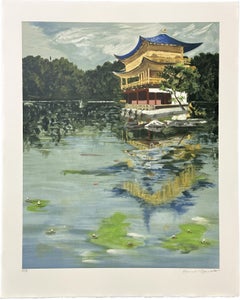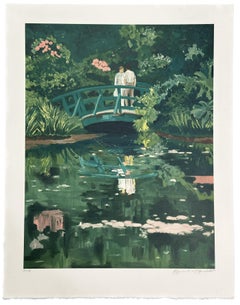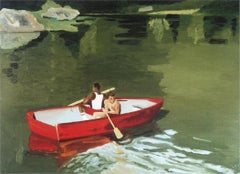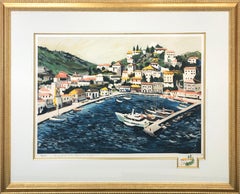Tony Bennett Lithographs
1990s Contemporary Still-life Prints
Lithograph
Tony BennettCHINESE VASE Signed Lithograph, Tony Bennett, Still Life, Flowers, Orange Lilies, c.1990
1990s American Impressionist Landscape Prints
Lithograph
1990s American Impressionist Landscape Prints
Lithograph
1980s American Impressionist Landscape Prints
Lithograph
Recent Sales
1990s Prints and Multiples
Lithograph
1980s Contemporary Landscape Prints
Paper, Lithograph
1980s Contemporary Landscape Prints
Paper, Lithograph
1980s American Impressionist Landscape Prints
Lithograph
People Also Browsed
Mid-20th Century Italian Mid-Century Modern Carts and Bar Carts
Bamboo, Rattan
Late 19th Century Impressionist Landscape Paintings
Canvas, Oil
20th Century Impressionist Landscape Paintings
Masonite, Oil
1960s Modern Portrait Prints
Linocut
Vintage 1970s Italian Coffee and Cocktail Tables
Walnut
Vintage 1910s English Dinner Plates
Enamel, Gold
1990s Italian Renaissance Sterling Silver
Sterling Silver
2010s Pop Art Sculptures
Glass
1960s Cubist Figurative Prints
Paper, Etching
Early 20th Century German Black Forest Animal Sculptures
Wood
Vintage 1940s American Political and Patriotic Memorabilia
Cotton
20th Century American Books
Paper
21st Century and Contemporary European Books
Paper
2010s Vietnamese Dressers
Oak
21st Century and Contemporary German Mid-Century Modern Chandeliers and ...
Metal, Iron
Vintage 1940s Books
Tony Bennett for sale on 1stDibs
Anthony Dominick Benedetto, known professionally as Tony Bennett, was an American singer of traditional pop standards, big band, show tunes, and jazz. He was also a painter, having created works under his birth name that are on permanent public display in several institutions.
Whether he was performing as Tony Bennett or painting as Anthony Benedetto, he offered to the recipient of his artistry a bridge to his personal values and views of the world. He put his emotions into his work and with that created a strong connection that is the necessary result of any successful artistic endeavor.
Tony Bennett was an artist. He was best known as a revered performer, the recipient of accolades by his peers and honors by his profession. Tony Bennett was also a visual artist, painting under his family name of Benedetto. The painter was an alter ego to the performer, who lived out a passion that was personal and introspective.
Find original Anthony Benedetto art on 1stDibs.
(Biography provided by Brightcolors)
Finding the Right Prints-works-on-paper for You
Decorating with fine art prints — whether they’re figurative prints, abstract prints or another variety — has always been a practical way of bringing a space to life as well as bringing works by an artist you love into your home.
Pursued in the 1960s and ’70s, largely by Pop artists drawn to its associations with mass production, advertising, packaging and seriality, as well as those challenging the primacy of the Abstract Expressionist brushstroke, printmaking was embraced in the 1980s by painters and conceptual artists ranging from David Salle and Elizabeth Murray to Adrian Piper and Sherrie Levine.
Printmaking is the transfer of an image from one surface to another. An artist takes a material like stone, metal, wood or wax, carves, incises, draws or otherwise marks it with an image, inks or paints it and then transfers the image to a piece of paper or other material.
Fine art prints are frequently confused with their more commercial counterparts. After all, our closest connection to the printed image is through mass-produced newspapers, magazines and books, and many people don’t realize that even though prints are editions, they start with an original image created by an artist with the intent of reproducing it in a small batch. Fine art prints are created in strictly limited editions — 20 or 30 or maybe 50 — and are always based on an image created specifically to be made into an edition.
Many people think of revered Dutch artist Rembrandt as a painter but may not know that he was a printmaker as well. His prints have been preserved in time along with the work of other celebrated printmakers such as Pablo Picasso, Salvador Dalí and Andy Warhol. These fine art prints are still highly sought after by collectors.
“It’s another tool in the artist’s toolbox, just like painting or sculpture or anything else that an artist uses in the service of mark making or expressing him- or herself,” says International Fine Print Dealers Association (IFPDA) vice president Betsy Senior, of New York’s Betsy Senior Fine Art, Inc.
Because artist’s editions tend to be more affordable and available than his or her unique works, they’re more accessible and can be a great opportunity to bring a variety of colors, textures and shapes into a space.
For tight corners, select small fine art prints as opposed to the oversized bold piece you’ll hang as a focal point in the dining area. But be careful not to choose something that is too big for your space. And feel free to lean into it if need be — not every work needs picture-hanging hooks. Leaning a larger fine art print against the wall behind a bookcase can add a stylish installation-type dynamic to your living room. (Read more about how to arrange wall art here.)
Find fine art prints for sale on 1stDibs today.
